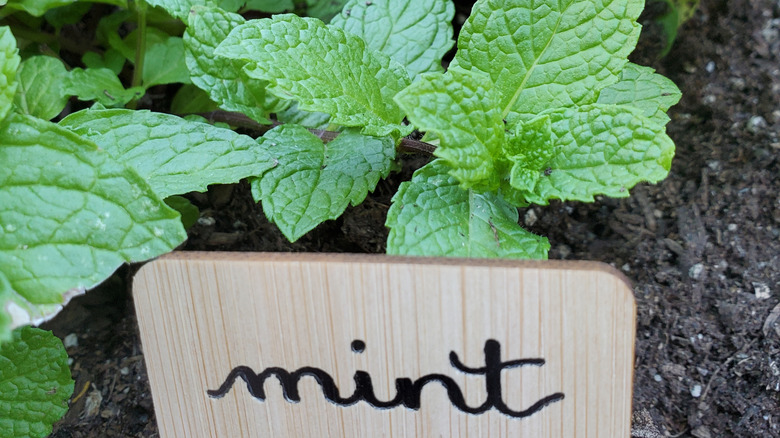Growing Healthy Tomatoes Is A Breeze When You Plant Them Near One Fragrant Herb
The tomato (Solanum lycopersicum) is one of the most popular most popular fruits or vegetables you can grow from seed in your garden. Since they're used in all kinds of recipes — from pasta sauce to shakshuka — it's no wonder that tomatoes are a gardening mainstay. And if you're thinking of planting some, help ensure they stay safe from pests by planting them next to some mint.
Companion planting is a gardening technique wherein two specific plants are put next to each other because they benefit each other, often by having complementary growth needs or repelling pests. Mint is a great neighbor for tomato because it deters pests like aphids, flea beetles, and ants. Aphids pierce tomato plant leaves to suck out nutrients, which stunt plant growth and output. Flea beetles chew holes into the leaves and spread to other plants. And we don't want ants, because they often protect aphids.
Mint steps in here and is used to repel these nasty critters thanks to its strong aroma, which pests hate. It also overpowers the scent of tomatoes, fortunately, so pests don't even notice they are there in your garden. The herb is an ideal companion for tomatoes and makes things a little easier for gardeners, too.
Mint provides beneficial insects for tomatoes
Mint does more than just repel unwanted bugs: It attracts beneficial hoverflies, earthworms, and predatory wasps. Hoverfly adults eat nectar from the mint plant, and their carnivorous larvae eat many pests that trouble tomato plants, like aphids. Mint also attracts earthworms, which can aerate soil and break down organic matter that makes soil better for plants. And predatory wasps may sound scary, but they really just eat bugs that tend to disrupt tomato plants.
Beyond attracting massive pest control, mint also brings pollinators like butterflies and bees to your garden. They love the scent of mint and will want to spend time near it. These pollinators will help pollinate not just your mint and tomatoes but also any nearby produce or flowers you've planted. Just note that mint is notorious for spreading like wildfire, so consider keeping it in a planter with your tomatoes, or learning how to prune mint, to keep it in check.
And setting up your garden for growing mint and tomatoes together is a cinch. They share similar growing requirements, along with USDA hardiness zones (tomatoes thrive in zones 3 to 11, and mint in zones 3 to 10). Both like full sun, although mint is also comfortable in partial shade. They require roughly the same soil pH, with tomatoes at 6.2 to 6.8 and mint at 6.5 to 7.0. Gardening doesn't get any easier (or more delicious) than this pairing!

